Brodsky Quartet - Rhythm & Texture (2010)
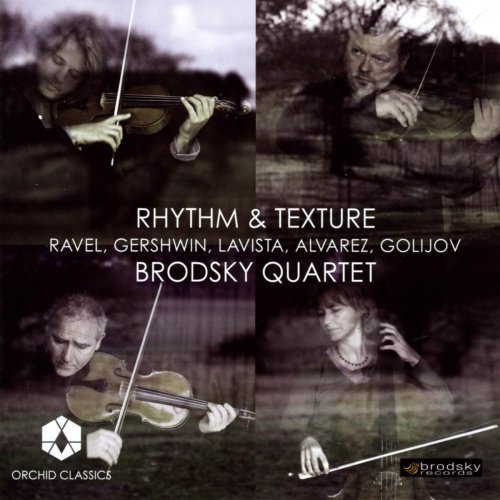
Artist: Brodsky Quartet
Title: Rhythm & Texture
Year Of Release: 2010
Label: Orchid Classics
Genre: Classical
Quality: flac lossless
Total Time: 01:12:35
Total Size: 273 mb
WebSite: Album Preview
TracklistTitle: Rhythm & Texture
Year Of Release: 2010
Label: Orchid Classics
Genre: Classical
Quality: flac lossless
Total Time: 01:12:35
Total Size: 273 mb
WebSite: Album Preview
01. String Quartet in F major: I. Allegro moderato, tres doux
02. String Quartet in F major: II. Assez vif, tres rhythme
03. String Quartet in F major: III. Tres Lent
04. String Quartet in F major: IV. Vif et agite
05. Lullaby (Version For Chamber Ensemble)
06. Reflejos De La Noche
07. Metro Chabacano (version for string quartet)
08. Tenebrae (Version For String Quartet)
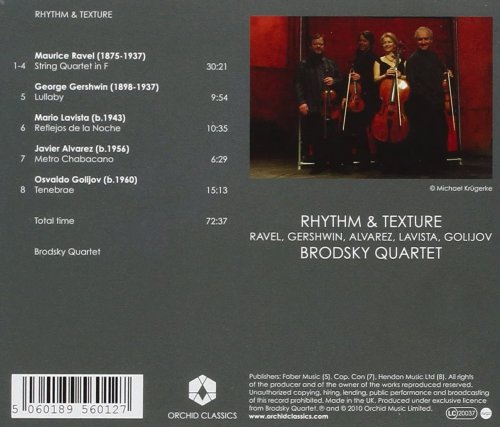
These five composers seem to share one ideal – that musical barriers are to be deplored and ignored in favour of freedom of expression, whatever the style.
Widely regarded as the master of orchestration Maurice Ravel was fascinated by music of all nationalities and idioms, and so greatly supported George Gershwin when he travelled to Europe to seek acceptance as a ‘serious’ composer. Gershwin avidly immersed himself in all genres, saying “Good music should be valued regardless of style or category”. He was a great admirer of the European composers, seeking (but not receiving) tuition from Ravel, Schönberg and others. The financial success of his popular output enabled him to support the work of his mentors, for example funding the early recordings of Schönberg’s string quartets. Ravel rewarded the young American with tributes to his style, openly modelling his Violin Sonata and G major Piano Concerto on the jazz idiom he admired. That the two friends died in the same year is a poignant coincidence, especially sad given Gershwin’s young age.
Osvaldo Golijov grew up in an Eastern European Jewish household in Argentina and was raised on classical chamber music, Jewish liturgical and klezmer, and the new tango of Astor Piazzolla. His studies took him from his native Argentina to Israel and the USA, where he became absorbed by the colliding musical traditions of both countries, leading to a unique compositional voice which has taken the musical world by storm.
Teacher and pupil Mario Lavista and Javier Alvarez both studied in Europe and the USA as well as their native Mexico and have held professorial and Composer-in-Residence posts at major musical institutions worldwide. Though both are loyal to their Latin-American roots throughout their prolific output, they convey many flavours through a variety of compositional styles, experimenting with improvisation and electro-acoustic techniques in addition to traditional notation. In the words of composer John Adams, “The music of Javier Alvarez reveals influences of popular cultures that go beyond the borders of our own time and place,” an accolade which can be applied to all the composers celebrated here.
Ravel was a master of instrumental colour with a mature compositional style even in his early twenties when he came to write the String Quartet in F. The work is dedicated “to my dear teacher Gabriel Fauré” but is often said to be inspired by Debussy’s quartet written a few years earlier. The two shared a friendly rivalry, not felt by them but perceived by others – indeed the elder is known to have urged his young colleague “in the name of God… to change not a note” after the work was criticised for, amongst other things, containing parallel 5ths (one of its greatest hallmarks) and failed to win the Prix de Rome and the Paris Conservatoire award. Even its dedicatee, Fauré, criticised it and the whole episode led to Ravel leaving the Conservatoire in a despondent state, though shortly afterwards to be re-elevated on a wave of public support.
Despite the diversity of the composer’s influences and inspiration, the work is firmly based in the classical form and opens with a pastoral impressionist painting of fine colour and breathless beauty. Extensive and dramatic use of pizzicato is the main feature of the second movement, like that of the Debussy quartet. Both were inspired by the sounds of gamelan, but in Ravel’s case, also by his maternal homeland of Basque Spain, with his use of cross-rhythms between 3/4 and 6/8. The central “trio” section and the subsequent third movement both contain elements of the jazz idiom which so interested the composer, but this slow movement has become a classic of the quartet repertoire with its sublime themes and hazy textures reminiscent of a sizzling Midi summer. The quartet ends with a vibrant and frenzied finale in 5/8, again playing with cross-rhythms, Hispanic and jazz elements and finishing with a flamboyant flourish.
Gershwin’s Lullaby is one of the few chamber works he wrote and is an early example of his aspiration to ‘serious’ composition, an exercise in scoring for a standard classical ensemble. Such an academic premise nevertheless belies a playful almost programmatic approach – one can clearly sense the different stages of the complicated procedure involved in putting an infant to bed! Musical-box tinkling and story-telling, the child pleading for ‘just one more story’, exasperation from the parent (the final rendition of the lullaby theme comes in a strident fortissimo), and finally long yawns, blissful silence and tip-toeing out of the room. Muted throughout, the work’s delicate melody over a subtle syncopation reveals the dichotomy of styles at play in the composer’s tragically short life. He was not confident enough to have it published and it received its first performance many years after his death.
One can imagine the exhausted lullaby-singing parent finally escaping to the porch and relaxing with a drink in the heat of the night as the next work begins… In Reflejos de la Noche (String Quartet No.2) Lavista uses a unique method to evoke the atmosphere of a South American night – all four players are given only natural harmonics to play throughout the work’s one movement. The wonderful canvas of sounds and textures, invoking images of insects and sounds of the night, is all the more extraordinary given this self-imposed limitation.
Alvarez wrote his Metro Chabacanofor the opening of a kinetic installation by sculptor Marcos Limenez in one of Mexico City’s busiest subway stations of the same name and was played on a loop for commuters’ enjoyment for the following three months. It is a one-movement moto perpetuo with melodic fragments emerging from a continuous and intricately playful rhythmic background.
Osvaldo Golijov has said of his piece: “I wrote Tenebrae as a consequence of witnessing two contrasting realities in a short period of time in September 2000. I was in Israel at the start of the new wave of violence that is still continuing today, and a week later I took my son to the new planetarium in New York, where we could see the Earth as a beautiful blue dot in space. I wanted to write a piece that could be listened to from different perspectives. That is, if one chooses to listen to it ‘from afar’, the music would probably offer a ‘beautiful’ surface but, from a metaphorically closer distance, one could hear that, beneath that surface, the music is full of pain. I lifted some of the haunting melismas from Couperin’s Troisieme Leçon de Tenebrae , using them as sources for loops, and wrote new interludes between them, always within a pulsating, vibrating, aerial texture. The compositional challenge was to write music that would sound as an orbiting spaceship that never touches ground. After finishing the composition, I realised that Tenebrae could be heard as the slow, quiet reading of an illuminated medieval manuscript in which the appearances of the voice singing the letters of the Hebrew Alphabet (from Yod to Nun, as in Couperin) signal the beginning of new chapters, leading to the ending section, built around a single, repeated word: Jerusalem.”
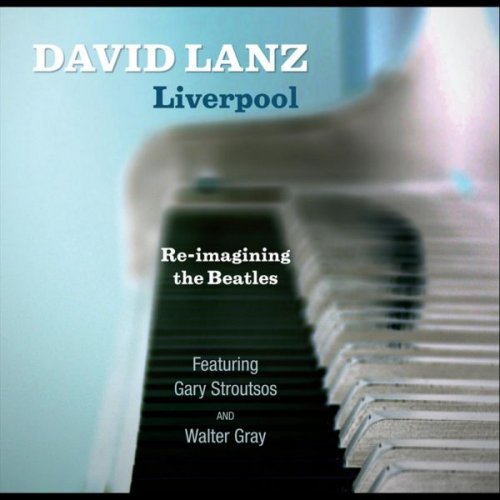
![Rachel Kitchlew, SFJ - Flirty Ghost (2025) [Hi-Res] Rachel Kitchlew, SFJ - Flirty Ghost (2025) [Hi-Res]](https://www.dibpic.com/uploads/posts/2025-12/1765896408_qvf41hr1ljj8a_600.jpg)
![Betty Carter - The Music Never Stops (2019) [Hi-Res] Betty Carter - The Music Never Stops (2019) [Hi-Res]](https://www.dibpic.com/uploads/posts/2025-12/1765896843_bcmn500.jpg)


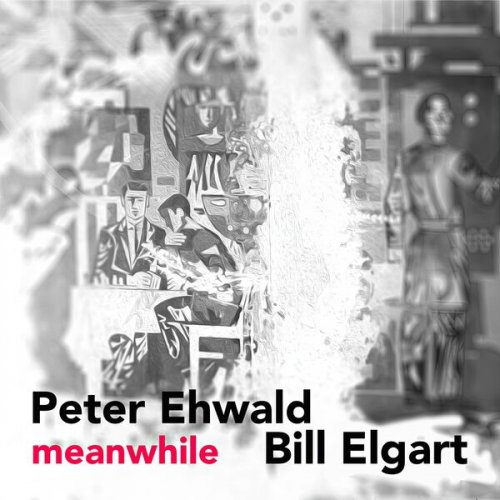
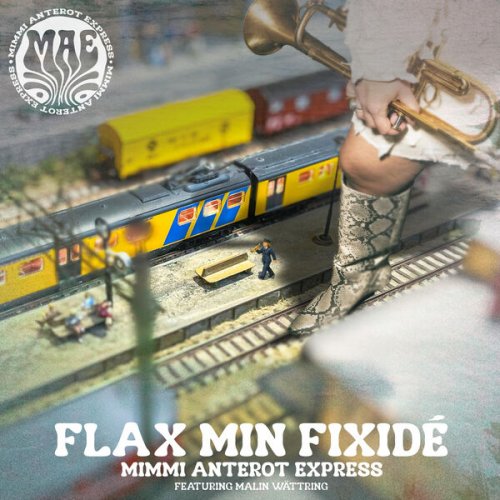
![Demo Rumudo - Second Nature (2025) [Hi-Res] Demo Rumudo - Second Nature (2025) [Hi-Res]](https://www.dibpic.com/uploads/posts/2025-12/1765883076_cover.jpg)
